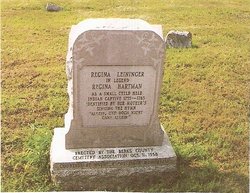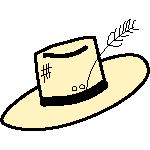In the years prior to the Revolutionary War, the frontier of Pennsylvania, the mountains and valleys near to and just west of the Susquehanna River, was dangerous territory. For years the French and the English competed for control of these lands, and the help of the native American indians was critical to both. Following the disasterous defeat of General Braddock, even the farmsteads east of the Susquehanna were often raided. Many were the settler cabins that were burned to the ground; many were the settlers themselves who were killed or taken into captivity by the indians. Mary Jemison was one; she was captured and adopted as an indian, and in later years preferred to stay among her new kin rather than return to white civilization. Regina Hartman was another, but she did return. This is Regina's story.
John Hartman was a German who had come to the new colonies from the Wurtemberg region. A Lutheran like many of his countrymen, Hartman chose to bring his family to the province of William Penn, as it still welcomed those of all religious persuasions. In his search for good land to farm and provide for that family, the Hartmans had settled in Berks County, part of the valley of the Susquehanna.
In addition to John and his wife Magdelena, the family included four children: George, aged 14; Regina, aged 12; Barbara, a few years younger, and baby Christian. There was also the beloved family dog, Wasser. They all worked hard and were well off for the place and time. Each evening as the children were put to bed, their mother would sing them the old German hymns she remembered from the homeland and her own childhood.
It was a bright fall morning in October 1755, the kind of day that made one forget that a Pennsylvania mountain winter wasn't far away. But the Hartman family would never forget this day.
After breakfast, as he did each morning, John Hartman led the family in prayers of thankfulness. Then he and George prepared to work in the far field. The girls would clean up the breakfast, then they had housework to do. Mrs. Hartman, taking baby Christian, would ride the horse to the mill for flour, and to visit a sick neighbor. As she left the yard, her family waved from the doorway and wished her a safe trip.
Back in the house, the family was surprised a short while later to hear Wasser, their faithful dog, growling and snarling in the yard. This was unlike him - he was big, but friendly to all. John Hartman went to the door just in time to see the big dog leap upon an Indian in the yard, knocking him to the ground. In an instant the Indian's companion tomahawked the poor dog. As Wasser fell, John Hartman went for his rifle, but before he could reach it, the cabin door was flung open and several Indians rushed in. They shot John Hartman and son George where they stood. Barbara climbed the ladder to the loft, trying to escape. Regina threw her hands to her face. "Herr Jesus! Herr Jesus!" she shrieked. For a brief moment, this seemed to confuse the Indians, but they quickly recovered. They dragged poor Barbara down from the loft, and proceeded to eat the leftover breakfast food, and then to ransack the cabin, eating or taking all the foodstuffs they could find.
Finishing quickly, the Indians tied Regina and Barbara together and herded them out the door. At the edge of the yard, another young girl was tied to a fence post. She was soon tied together with the other two. Then, stopping only to set fire to the house and barn, the Indians, with their captives, set off into the forest. In no time, they were miles away, and all the hard work of the Hartmans was reduced to ash.
Later in the day, Mrs. Hartman and Christian returned. As they rode toward the house on the family's horse, Mrs. Hartman at first thought she had gone the wrong way, because she couldn't see the family cabin. Great was her surprise, which quickly turned to shock, when she found the charred remains of not only her home, but her husband and son as well. She rode as fast as she could with the baby to the next neighbor to spread the alarm. Men from the area gathered and tried to go after the Indians, but they were poor trackers, and the Indians had a huge head start and were moving fast. Mrs. Hartman found out that another farm had been attacked and burned, and that another young girl, Susan Smith, aged 8, had been taken as a captive. The rescue party never caught up with the Indians of course, but they did find the body of young Barbara. She had probably tried to escape, and so was killed by the Indian party.
Poor Mrs. Hartman mourned for her dead husband and son and daughter of course, but the uncertainty of not knowing the fate of Regina was even harder for her. She took some solace in the fact that young Christian was still with her, alive and well. Time passed - Mrs. Hartman remarried. Her son Christian was now a stripling young man. But she still wished she knew what had become of her oldest daughter.
What had happened to Regina Hartman? Indians did not take captives, and take them many miles through the forest, just to kill them later. Young whites, or those too old or infirm to keep up on the trek away from the raiding sites, were killed quickly. Those who resisted or tried to get away were killed, as had happened to Barbara Hartman. But those that made the trip were generally adopted into the tribe, sometimes given or even sold to other tribes. Once adopted, whites were generally treated well, and many lived willingly among the Indians for years. Such was the case with Regina Hartman and Susan Smith, the two girls who had been taken from Sherman Valley.
At first, both wished they could escape and return to their homes. But they were smart enough to know that they had no idea how to get back. They had most likely been taken to the Ohio country, perhaps even to the upper lake. The girls also knew that the Indians, who treated them well, would kill them if they tried to escape. After a few years, their new lives were accepted, and they gradually forgot their earlier lives, hardly remembering those long ago days. They occasionally spoke German to each other, but only if the Indians couldn't hear them. Most often they spoke their newly learned Indian tongue to each other as well as to the Indians. Regina had an Indian name, Sawquehanna. Susan was called Knoloska.
Regina Hartman and Susan Smith had been captured in one of the many raids conducted by the French and their various Indian allies as England and France struggled for control of the frontier beyond the English settlements along the Atlantic coast. Eventually, in 1763, eight years after Regina was taken from her home, the French were bested, and the Flag of Great Britain was the only one that flew over all of Pennsylvania. As part of the peace settlement between England, France, and the frontier tribes, the Indians were required to return all white captives that had been abducted from their homes. Hundreds of captives were brought from the western lands to Fort Pitt, where Pittsburgh now stands. Family members came to Fort Pitt from all over to try and recognize their long separated loved ones, and on September 13, 1764, the captives were lined up on the parade ground of the fort. Many happy reunions took place as families were reunited. Some of the returned captives had no family left, and preferred to return and live as Indians. There were many joyous reunions of captives and their families, but some fifty of the captives, including Sawquehanna and Knoloska, were not found by family.
Colonel Henry Bouquet, the English commander in the west, was not yet ready to give up. He brought all the remaining captives back east to Carlisle, in the Cumberland Valley, which was then the farthest west town of any significance on the frontier. Notices were published in the newspapers of eastern Pennsylvania for families to come and see if these captives were known to them. Susan Smith's parents were dead, but an Aunt and Uncle recognized their niece, and she was eager to go and live with them. She and Regina, Knoloska and Sawquehanna, who had lived as sisters for so long among the Indians, had a tearful parting.
Magdelena Hartman, Regina's mother, had heard, via the German pastor at Tulpehocken, of the returned captives and she too had gone to Carlisle. She walked among the freed captives, looking at every face, into every eye. It had been nine years. Regina was only twelve when she was taken. "My daughter is not here," she tearfully told Colonel Bouquet. "Look again," said the Colonel. "No," insisted the woman, "my daughter is not here."
"Isn't there some special way you could recognize her? A mark of some kind?" "No," said Mrs. Hartman, "my daughter was perfect, unblemished in any way."
"Perhaps a word, or a song that she would recognize?" Mrs. Hartman thought back to the old German hymns she would sing to her children. Perhaps that would bring a spark of recognition. She started to sing, but feeling foolish, stopped quickly. "No, no," insisted Colonel Bouquet, "go on, go on."
So once again, Mrs. Hartman began softly to sing a hymn, walking slowly among the remaining captives as she did so. "Allein, und doch nicht ganz allein, Bin ich in meiner Einsamkeit." Up and down the line she went. Sawquehanna, the Indian girl, heard the sound, listened intently as something was awakened in her memory. Suddenly she ran to Magdelena, starting to sing herself as she ran. "Mutter, mutter!" she cried. "Regina!" her mother cried in return. It was a most tearful reunion as the two women ran into each other's arms, still singing together the beautiful German hymn they had sung so long ago.
Even Colonel Bouquet and the other English officers couldn't help shedding a tear. It was December 31, 1764. After nine long years, Regina Hartman had come home!
The version above is largely taken from "Stories of Pennsylvania", an 1897 publication of the American Book Co., authored by Joseph Solomon Walton and Martin G. Brumbaugh (who would become Governor of Pennsylvania in 1915). They in turn may have found the story in "The Journals of Henry Melchior Muhlenberg". Muhlenberg, a colonial era German Lutheran religious figure and historian, told a similar tale, which he heard directly from the mother of the captive Regina. A very similar tale of a Regina Leininger from Schuylkill County can be found in contemporary literature. See also the Ruffner Family History - www.horseshoe.cc/pennadutch/families/ruffner/ruffner.htm
Neither Walton and Brumbaugh nor Muhlenberg give a first name for Mrs. Hartman. Muhlenberg in fact does not mention the family's last name, further conflicting the Hartman/Leininger issue. The name Magdelena was obtained from a historical marker on the town square in Carlise, PA., regarding the return of the indian captives from Fort Pitt.
This tale also appears in "Where The Rivers Meet" by Clarence Macartney, The Gibson Press, Pittsburgh PA. 1946.
The English translation of the first stanza of this hymn Mrs. Hartman sang is as follows: "Alone, yet not alone am I; Though in this solitude so drear; I feel my Saviour always nigh; He comes the very hour to cheer; I am with Him, and He with me; E'en here alone I cannot be."
The photo below is of the grave of Regina - note it gives both the names Leininger and Hartman - which is in the Christ Church Cemetery in Stouchsburg, Berks County, Pennsylvania.


